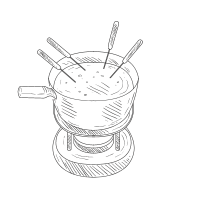Indulge in the Swiss Tradition: A Step-by-Step Guide to Making Perfect Fondue
Introduction: A Culinary Adventure Awaits
Fondue, a beloved Swiss culinary tradition, evokes images of cozy gatherings, laughter, and the irresistible aroma of melted cheese. This communal dining experience transcends mere eating; it’s an opportunity to bond, share stories, and savor the simple pleasure of good food and even better company. While the concept might seem intimidating at first, mastering the art of fondue is surprisingly achievable. This comprehensive guide will equip you with the knowledge and confidence to create an unforgettable fondue experience in your own home. From selecting the ideal cheese blend to mastering the perfect dipping technique, we’ll delve into every aspect of this Swiss culinary gem.
The History and Allure of Swiss Fondue
Fondue, derived from the French verb fondre meaning to melt, originated in the Swiss Alps centuries ago. Initially a peasant dish born out of necessity during harsh winters, fondue provided a resourceful way to utilize aging cheese and stale bread. The communal pot, heated over an open fire, fostered a sense of togetherness and warmth, solidifying its place in Swiss culture. Over time, fondue transcended its humble beginnings, evolving into a celebrated national dish enjoyed by people from all walks of life. Today, fondue remains a symbol of Swiss heritage and a testament to the enduring power of simple, flavorful food.
Essential Equipment: Gearing Up for Fondue Success
Creating the perfect fondue experience requires a few specialized tools, each playing a crucial role in achieving optimal results.
1. Fondue Pot (Caquelon)
The heart of any fondue setup is the caquelon, a specifically designed pot crafted to evenly distribute heat and maintain the ideal fondue consistency. Traditional caquelons are made from ceramic or cast iron, prized for their heat retention properties. Electric fondue pots offer modern convenience with adjustable temperature controls. Choose a size that accommodates your group, generally allowing about 1/2 pound of cheese per person.
2. Fondue Forks
Long-stemmed fondue forks with two or three prongs are essential for dipping without losing your bread in the molten goodness. Opt for forks with heat-resistant handles to prevent burnt fingers.
3. Heat Source
If using a traditional fondue pot, a reliable heat source is paramount. Small portable gas burners or butane stoves provide consistent heat and allow for easy temperature adjustments. Ensure proper ventilation when using these types of burners.
4. Other Essentials
To complete your fondue arsenal, gather a few additional items:
- Cutting board and sharp knife for preparing ingredients.
- Wooden spoon for stirring the fondue.
- Small plates or bowls for dipping sauces and discarded crusts.
- Fondue warmer or tea light to maintain the fondue’s temperature.
Choosing the Perfect Cheese Blend: The Foundation of Flavor
The soul of any fondue lies in the carefully orchestrated blend of cheeses. Swiss cheeses, renowned for their melting properties and distinctive flavors, reign supreme in the fondue pot. While countless variations exist, here are a few classic combinations to inspire your culinary creativity:
1. Classic Gruyère and Emmental Fondue
This timeless duo forms the bedrock of traditional Swiss fondue. Gruyère, with its nutty and slightly sweet notes, harmonizes beautifully with the milder, earthier Emmental.
2. Vacherin Fribourgeois Fondue
For those seeking a more intense fondue experience, Vacherin Fribourgeois is an excellent choice. This pungent, soft cheese melts into a luxuriously creamy fondue. It pairs well with potatoes and crusty bread.
3. Appenzeller Fondue
Appenzeller, with its robust, slightly spicy flavor, adds a unique dimension to fondue. Combine it with Gruyère and Emmental for a well-balanced and flavorful fondue.
Mastering the Fondue Technique: A Step-by-Step Guide
With your equipment and ingredients prepped, it’s time to embark on the fondue-making journey. Follow these steps to create a fondue experience that will impress even the most discerning palate:
1. Prepare the Fondue Pot:
Rub the inside of the fondue pot (caquelon) with a cut clove of garlic. This classic technique imparts a subtle garlicky aroma and prevents the cheese from sticking.
2. Heat the Wine:
Pour the dry white wine into the caquelon and heat over medium heat. The wine should be simmering gently, not boiling.
3. Gradually Add the Cheese:
Add the grated cheese to the simmering wine in small handfuls, stirring constantly in a figure-eight motion. This ensures even melting and prevents the cheese from clumping.
4. Thicken with Cornstarch (optional):
If desired, you can thicken the fondue slightly by making a slurry with cornstarch and a tablespoon of kirsch (cherry brandy) or wine. Whisk the slurry into the fondue and cook for a minute or two until thickened.
5. Season and Serve:
Season the fondue with freshly grated nutmeg, black pepper, and a pinch of salt to taste. Transfer the caquelon to the fondue warmer or burner at the center of your table and let the feasting begin!
The Art of Dipping: Etiquette and Enjoyment
Fondue is best enjoyed as a leisurely and social dining experience. Encourage your guests to participate in the fun by spearing a piece of bread or other dippers onto their fondue forks and swirling it in the molten cheese. Once coated, give it a gentle shake to prevent drips and enjoy!
Fondue Etiquette Tips:
- If you drop your bread in the fondue (it happens!), tradition dictates a playful forfeit, such as singing a song or buying the next round of drinks.
- Avoid double-dipping! Spear a fresh piece of bread for each dip.
- Don’t be afraid to experiment with different dipping sauces and sides to personalize your fondue experience.
Beyond the Breadbasket: Exploring Dipping Delights
While crusty bread is the quintessential fondue companion, a world of dipping possibilities awaits. Expand your fondue horizons with these tantalizing options:
1. Vegetables:
Blanched or roasted vegetables provide a refreshing contrast to the richness of the cheese. Broccoli florets, cauliflower, bell pepper strips, cherry tomatoes, and steamed baby potatoes all make excellent dipping choices.
2. Fruits:
The sweetness of fresh fruits beautifully complements the savory fondue. Apple slices, pear wedges, grapes, and strawberries add a burst of flavor and color to your fondue spread.
3. Proteins:
For a more substantial fondue experience, consider adding cooked proteins to the mix. Bite-sized pieces of grilled chicken, sausage, or shrimp take on a delightful cheesy coating.
4. Other Delights:
Don’t be afraid to get creative! Steamed new potatoes, gherkins, pickled onions, and even pretzels can enhance your fondue adventure.
Elevating the Experience: Dipping Sauces and Accompaniments
While fondue is undeniably delicious on its own, dipping sauces and flavorful accompaniments add another layer of enjoyment to the experience. Here are a few ideas to elevate your fondue game:
Dipping Sauces:
- Aioli: This garlicky mayonnaise-based sauce adds a creamy, pungent kick.
- Honey Mustard: The sweet and tangy notes of honey mustard provide a delightful contrast to the rich cheese.
- Horseradish Cream: The sharp bite of horseradish adds a zesty element to the fondue.
- Sweet Chili Sauce: For those who enjoy a touch of heat, sweet chili sauce offers a flavorful punch.
Accompaniments:
- Pickles: Cornichons, gherkins, and pickled onions cut through the richness of the cheese with their acidity.
- Salads: A simple green salad with a vinaigrette dressing provides a refreshing counterpoint to the fondue.
- Chutneys: Apple chutney, fig jam, or cranberry sauce adds a touch of sweetness and complexity to the fondue experience.
Troubleshooting Tips: Ensuring Fondue Success
Even with the best intentions, fondue can sometimes present a few challenges. Fear not! These troubleshooting tips will help you navigate any fondue faux pas:
1. Fondue Too Thick:
Gradually whisk in a tablespoon or two of warmed wine or kirsch to loosen the fondue’s consistency.
2. Fondue Too Thin:
Create a slurry with a teaspoon of cornstarch and a tablespoon of wine or kirsch. Whisk the slurry into the fondue and cook for a minute or two until thickened.
3. Cheese Clumping:
Lower the heat and continue stirring vigorously in a figure-eight motion. If the cheese still appears clumpy, add a teaspoon of lemon juice to help smooth it out.
4. Fondue Sticking to the Pot:
Ensure the heat is not too high and stir the fondue regularly to prevent sticking. If sticking occurs, try adding a tablespoon of warmed wine or kirsch to the bottom of the pot and gently scrape the cheese from the sides.
Conclusion: Embracing the Fondue Tradition
Mastering the art of Swiss fondue opens a door to a world of culinary possibilities and shared enjoyment. From selecting the ideal cheese blend to pairing it with an array of dipping delights, the journey of fondue is as rewarding as the destination. So gather your loved ones, embrace the warmth of tradition, and embark on an unforgettable fondue adventure.

